ontrack WBL Release Notes
Maytas 5.24 SP1 Release Notes
Note regarding submissions
We would like to remind providers to create a submission early and check for any errors using reports from the appropriate software (i.e. the FIS or LLWR-Inform). Welsh providers should also remember to download their ULI file. After submission to the ESFA or DfE, providers should check that data has submitted correctly using the available reports. Providers should check that all their expected starts and completions are submitted correctly, and that start and outcome payments correctly match the PFR or ACE funding reports.
Our support desk gets extremely busy in the days prior to the submission deadlines, and although we try and prioritise submission-related queries, we cannot guarantee assistance if queries are sent late. If you do encounter any issues, please ensure that you contact Maytas Support as soon as possible, as we can only rectify issues of which we are aware. We also recommend checking Maytas Communities regularly for information on any known issues and solutions. Tribal cannot be held responsible for any issues caused by your failure to comply with this advice.
Technical specification
The latest Maytas and Maytas Hub technical specification can be found here.
Once the upgrade has been completed, the version number should be checked to ensure it has been successful.
- Start Maytas and go to Support on the toolbar.
- Click About.
- The version numbers should read 5.24.8120.2. If you have any other version, please ensure you have followed the upgrade instructions correctly. If you require assistance, please contact Maytas Support.
It is the responsibility of customers to ensure that users carry out any required user acceptance testing and sign off on the upgrade.
Complete the Upgrade
Features Added in the Upgrade
These are the main updates in the upgrade:
- PFR Reconcilers for 2022/23
- Updated funding calculations and Financial Planning for 2022/23
- Report viewer update
- Fixes to a number of issues
Import Funding Information
The process for importing the required funding information into Maytas is as follows:
- The LARS for 2021/22 should be imported.
- Postcode data for 2021/22 should be imported.
- Once all data has been imported, ensure that the funding cache is refreshed (either on a database schedule or a manual update out of working hours).
Import LARS
The LARS should be imported as follows:
- Download the latest LARS MDB file. At the time of this release, the latest version is the LARS MDB version 8.
- In Maytas, go to Exports on the toolbar.
- On the ILR Tools panel of the ribbon, go to Uploads | Upload Funding Information | Upload LARS (Version 8).
- Browse to and select the downloaded LARS file and click Open.
- The file will now be imported. Click OK on the message which appears.
Progress on the import can be checked by going to Home | Server Tasks | Server Jobs. Typically it will take several minutes.
Import Postcode File
- Obtain the postcode uplift factors file - Download the zip file under 2022 to 2023 uplift factors by postcode and LLSOA: CSV files.
- In Maytas, go to Exports on the toolbar.
- On the ILR Tools panel of the ribbon, go to Uploads | Upload Postcodes| Upload Post Code Data (2022/23).
- Browse to and select the postcode uplifts zip file and click Open.
- The file will now be imported. Click OK on the message which appears.
Progress on the import can be checked by going to Home | Server Tasks | Server Jobs. Typically this will take several minutes.
Note on the Funding Cache
By default, the funding cache will update overnight so that funding information in Maytas uses the newly-imported FIS and postcode information. Please check with your system administrator if you are unsure if or when the funding cache is updated on your system. You can also manually set the funding cache to update by going to Management | Profiles and clicking the Funding Cache button, though please be aware that this may take a long time and may use a large amount of system resources, which could affect performance for other users on the system.
Import PFR Reconciler Reports
The PFR Reconciler reports for 2022/23 should be imported as follows:
- In Maytas, go to Home on the toolbar and click Import on the Reports panel of the ribbon.
- Click Add Files.
- Browse to the Maytas 5\Extras\Module Reports folder of the upgrade.
- Select PFR Reconcilers – 2223.m5rep and click Open.
- Click Finish.
- Once the reports have finished importing, click Finish.
Due to the size of the .rdl file for the FM36 PFR report, some report servers may produce the following error when importing:
Error: There was an exception running the extensions specified in the config file. —> Maximum request length exceeded.
This means that the report server's MaxRequestLength property is configured to only allow uploads up to a certain size, and the configuration must be changed to allow larger files to be uploaded. Please contact your system administrator to do this. Please note that Maytas Support cannot offer support on how to configure a SQL Server Report Server, as these are Microsoft products.
Maytas 5 Version 5.24.8120.2 Release Notes
PFR Reconcilers 2022/23
New PFR reconciler reports are now available to work with the 2022/23 PFR files. This year there are separate reports for funding models 35, 36 and 81 to reflect the substantially different formats of each PFR. The reports work the same as in previous years.
There are separate import options for each PFR file:
- Go to Management on the toolbar.
-
On the PFR section of the ribbon, click Upload and select the required 2022/23 PFR import option:
For FM35, go to PFR | Upload PFR (2022/23).
For FM81, go to PFR | Upload Trailblazer PFR (2022/23).
For FM36, go to FM36 Funding Reports and choose the file type to upload.
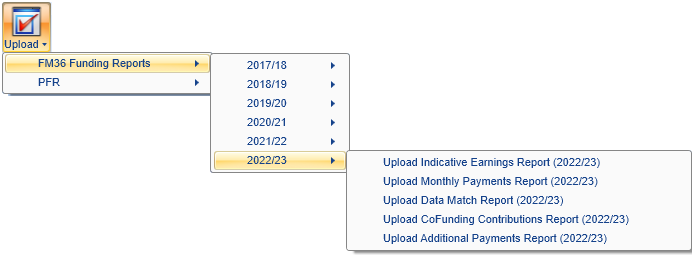
- Browse to and select the PFR file and click Open.
The file will now be imported. Click OK on the confirmation message which appears.
The PFR Reconciler reports require the 1.0.4.3 reports library upgrade SQL to have been run. Please follow the instructions below to upgrade the reports library.
Funding Model 35 PFR Reconciler Reports
The FM35 PFR reconciler reports can be accessed as follows:
- On the Home tab, click Reports Library.
- Go to the Finance folder and select one of the new reports:
- PFR Reconciler FM35 – 2223 – This shows a summary of funding differences, as well as tables showing matched rows with funding differences, rows in Maytas but not the PFR and rows in the PFR but not in Maytas.
- PFR Reconciler FM35 – Non-Funding Differences – 2223 – This shows matched rows which have differences in the non-funding columns (i.e. all columns which are not the month-by-month funding columns).
-
The parameters window will appear:
PFR – Select the PFR file from the list.
ILR file – Select the corresponding ILR file from the list.
Measure up to end of – This tells the report to only reconcile funding differences up to the end of a specific month. This is because Maytas data is highly likely to be updated in the time between the PFR being produced and the report being run – for example, leavers may be entered in Maytas who were live when the PFR was produced. This can result in inaccurate comparisons. Comparing Maytas funding data up to the period in which the PFR was produced should give a more accurate comparison than comparing current Maytas data.
Note that the following two parameters do not appear on the Non-Funding Differences report.
Show Differences Threshold (pence) – This determines the threshold in pence for the funding differences to be shown in the report. For example, the default of 10 will only include rows where there is more than a 10p total difference between Maytas and the PFR.
Show missing rows with zero values – For the section at the end of the report showing rows in the PFR but not in the Maytas ILR export (and vice-versa), this allows you to hide rows which have no funding against them. By default, these rows are included.
- Click View to run the report.
There are no column changes from the 2021/22 report.
Funding Model 81 PFR Reconciler Reports
The FM81 PFR reconciler reports can be accessed as follows:
- On the Home tab, click Reports Library.
- Go to the Finance folder and select one of the new reports:
- PFR Reconciler FM81 – 2223 – This shows a summary of funding differences, as well as tables showing matched rows with funding differences, rows in Maytas but not the PFR and rows in the PFR but not in Maytas.
- PFR Reconciler FM81 – Non-Funding Differences – 2223 – This shows matched rows which have differences in the non-funding columns (i.e. all columns which are not the month-by-month funding columns).
- The parameters window will appear:
PFR – Select the PFR file from the list.
ILR file – Select the corresponding ILR file from the list.
Measure up to end of – This tells the report to only reconcile funding differences up to the end of a specific month. This is because Maytas data is highly likely to be updated in the time between the PFR being produced and the report being run – for example, leavers may be entered in Maytas who were live when the PFR was produced. This can result in inaccurate comparisons. Comparing Maytas funding data up to the period in which the PFR was produced should give a more accurate comparison than comparing current Maytas data.
Note that the following two parameters do not appear on the Non-Funding Differences report.
Show Differences Threshold (pence) – This determines the threshold in pence for the funding differences to be shown in the report. For example, the default of 10 will only include rows where there is more than a 10p total difference between Maytas and the PFR.
Show missing rows with zero values – For the section at the end of the report showing rows in the PFR but not in the Maytas ILR export (and vice-versa), this allows you to hide rows which have no funding against them. By default, these rows are included.
- Click View to run the report.
There are no column changes from the 2021/22 report.
Funding Model 36 PFR Reconciler Reports
The FM36 PFR reconciler reports can be accessed as follows:
- On the Home tab, click Reports Library.
- Go to the Finance folder and select one of the new reports:
- PFR Reconciler FM36 – 2223 – This shows a summary of funding differences, as well as tables showing matched rows with funding differences, rows in Maytas but not the PFR and rows in the PFR but not in Maytas.
- PFR Reconciler FM36 – Non-Funding Differences – 2223 – This shows matched rows which have differences in the non-funding columns (i.e. all columns which are not the month-by-month funding columns).
-
The parameters window will appear:
Report type – This lets you choose whether to reconcile the indicative earnings report, the monthly payments report or the co-investment payments report. Each of these will determine the available PFR files to select from and the content displayed when the report is run.
PFR – Select the PFR file from the list.
ILR file – Select the corresponding ILR file from the list.
Measure up to end of – This tells the report to only reconcile funding differences up to the end of a specific month. This is because Maytas data is highly likely to be updated in the time between the PFR being produced and the report being run – for example, leavers may be entered in Maytas who were live when the PFR was produced. This can result in inaccurate comparisons. Comparing Maytas funding data up to the period in which the PFR was produced should give a more accurate comparison than comparing current Maytas data.
Note that the following two parameters do not appear on the Non-Funding Differences report.
Show Differences Threshold (pence) – This determines the threshold in pence for the funding differences to be shown in the report. For example, the default of 10 will only include rows where there is more than a 10p total difference between Maytas and the PFR.
Show missing rows with zero values – For the section at the end of the report showing rows in the PFR but not in the Maytas ILR export (and vice-versa), this allows you to hide rows which have no funding against them. By default, these rows are included.
- Click View to run the report.
The FM36 PFR reconciler can be run against four different PFR datasets for FM36: indicative earnings, monthly payments, co-investment payments and additional payments. This can be chosen in the Report type parameter.
Of these options, we expect the indicative earnings report to match the Maytas figures the closest, as this PFR data does not depend on certain factors which must be assumed in Maytas (these factors are not available and cannot be derived before the PFR data is produced). The monthly and co-investment payments reports do depend on these factors and so are likely to match the Maytas figures less closely. In very broad terms, the indicative earnings are the 'expected' figures and the payment reports are the actual figures.
On the co-investment view, the column Employer name from apprenticeship service has been renamed to Earliest employer name from apprenticeship service with co-investment. Otherwise there are no column changes from the 2021/22 report.
Report Viewer Update
An issue was identified where reports could not drill down in Maytas when using an SSRS 2019 report server, which was due to a report server update issued by Microsoft. To address this, the report viewer which Maytas uses for the Reports Library and MList / Report Generator has been updated to a newer version. While all previous functionality has been retained, there are some visual differences when running reports:
-
Parameters previously appeared in a separate window, whereas now they are displayed above the report results.
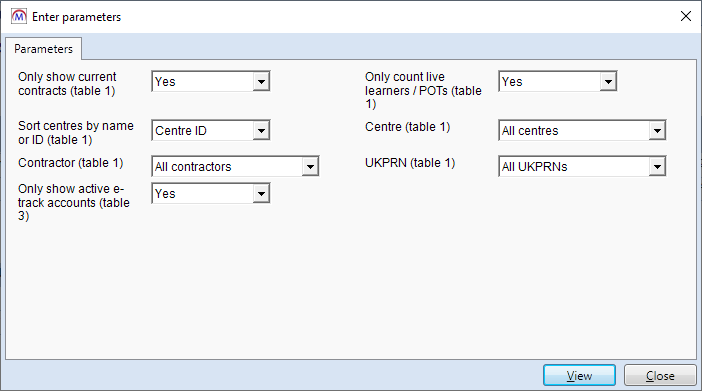
The old parameter view for the System Status report.

The new parameter view for the System Status report.
- The new parameters panel includes a toolbar which provides similar options to those on the ribbon.
- The new parameters panel can be hidden and displayed again using the arrow button
 at the centre-bottom of the panel.
at the centre-bottom of the panel.
Financial Planning 2022/23
The Financial Planning module now supports plans for 2022/23. After the upgrade, it is important to ensure the funding cache has been updated. In most cases this should be done automatically on a schedule (check with your system administrator), but it can also be done manually by going to Management | Profiles and clicking the Funding Cache button. This may take a long time and may use a lot of system resources, so it is strongly recommended to only update the funding cache outside of normal working hours.
To create a 2022/23 plan:
- Go to Management | Financial Plans.
- Double-click New Financial Plan.
- Select a 2022/23 contract to base the plan on and click Next.
- Enter a name for the plan and click Next.
- Select the funding models and funding line types you wish to use for the plan and click Next.
- Select the years and periods you wish to use for the plan and click Next.
- Click Finish.
The plan will now be created.
Before using any existing plans from 2021/22 and earlier, you should refresh their current data values and what if values. This can be done on each required plan by going to the Current Data Values and What If Values tabs and clicking the  button.
button.
Additional Column Information in DB Schema
The DB Schema module now displays the following information (read-only) for each column in the database:
- Data Type - The SQL Server data type (e.g. integer, varchar, datetime, etc)
- Is Nullable - Whether the column is permitted to have a null value (note that this is not the same as a blank value)
- Character Maximum Length - The maximum length of values in the column (if applicable, e.g. for a varchar)
To view this information for a column:
- Go to Tools on the toolbar.
- Select DB Schema on the General panel of the ribbon.
- Expand Tables on the left and then expand a table or view.
-
Select the column you wish to view. The details will appear on the right (if the Set button is displayed instead, you will need to click it first).

Data Collection Forms - Email Confirmation
A confirmation email can now be sent to a learner once they complete a data collection form, which is enabled by setting a flag against the form in the Screen Designer:
- Go to Tools on the toolbar and select New / Load on the Screens panel of the ribbon.
- Open the required form.
- On the Overview tab (on the left of the Screen Designer), tick the Email Learner checkbox.
- Click Apply.
- Go to Home on the toolbar and click the Sync button.
A configuration option is available to specify the content of the email:
- Click the M5 button at the top left and select Options.
- Go to Learner Login on the left (under the Maytas Hub Online header).
- In the Data Collection section on the right, tick the checkbox for the Trainee Data Collection Completion Email config.
- In the textbox for the config, enter the email body you wish to be sent to learners upon completion of a form. This can include the parameters {FNAME} and {LNAME}, which will display the learner's first and last names in the email.
- Click OK.
SITS Import 2022/23
The SITS Import has been updated to support the 2022/23 ILR format.
FE Workforce - Main Role Lookup Update
The FE Workforce export has been updated to match the 2021/22 specification. As part of this, the Main Role field has changed so that it has 65 possible values instead of 5, as the data is now required at a more granular level. As there is no direct mapping between the old lookups and the new ones, any data previously entered for this field must be re-entered as one of the new lookups.
EDRS Lookup Change
The EDRS Lookup control now functions as a text box rather than a lookup control, as the EDRS lookup service has been desupported.
DfE Catchment Fields
The DfE integration will now include the following fields in the download when Get Updates and Get All Participants are triggered:
| DfE field | Description | Maytas database column |
|---|---|---|
| Teach catchment | Indicates whether the participant is UK-based | TRAINEEPOT2.DFE_CATCHMENT |
| Teacher catchment ISO country code | Identifies which non-UK country the participant has registered from | TRAINEEPOT2.DFE_CATCHMENT_ISO_COUNTRY_CODE |
| Teach catchment country | Shows the text entered by the participant during their NPQ online registration (i.e. the name of their country) | TRAINEEPOT2.DFE_CATCHMENT_COUNTRY |
These fields are not displayed on the DfE Data tab by default, but can be added via the Screen Designer.
Maytas Hub Release Notes – Version 5.24.8120.2
The Learner Journey module is a streamlined view of a learner's important events on a month-by-month basis, available for assessor and learner users. The following events are included:
- Visits
- Objective target dates
- Data collection forms
- Skill Scans
- Learning plan targets
- Tasks
By default, only outstanding and overdue items are shown, but completed items can also be shown.
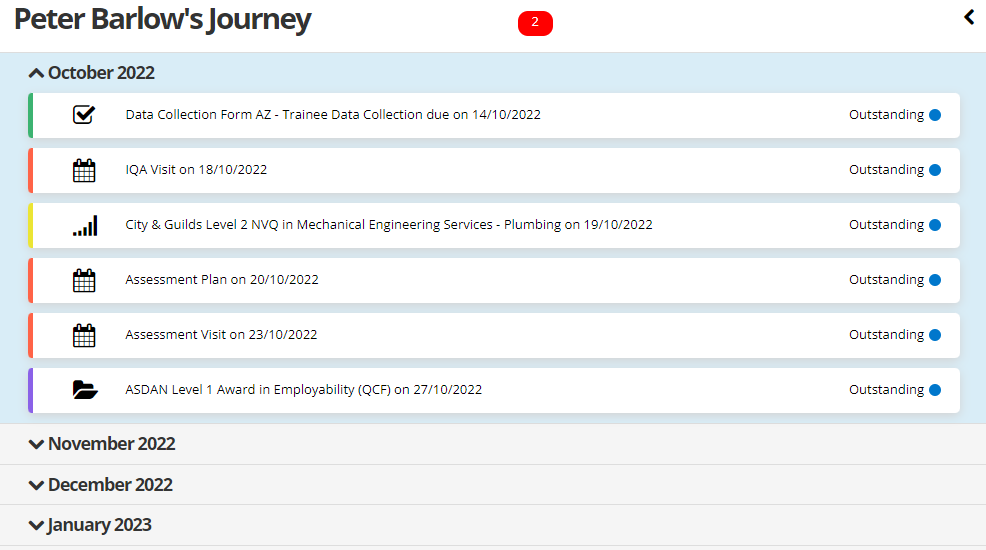
Viewing the Journey
When you first open the Learner Journey, the current month will be expanded and all other months will be collapsed. To expand a month, click the  button next to the month, and to collapse a month, click the
button next to the month, and to collapse a month, click the  button.
button.
By default, only the current and future months are shown for learners with a live POT. To display past months, click the arrow button at the top right to show the Filters panel, then tick the Show Past Periods box.
Each item within a month can be selected to view its basic details, which will appear in a panel on the right.

Some items will have additional options on the right - e.g. on the IQA Visit example above, the Message Learner envelope can be clicked to open a new message for the learner and the Open Visit button can be clicked to view the full details of the visit.
Once you have finished viewing an item, click the  button next to it to hide the panel.
button next to it to hide the panel.
If the learner has any overdue items, these will be indicated at the top-centre of the screen (such as the  button in the example above). Clicking the button will show the overdue items.
button in the example above). Clicking the button will show the overdue items.

Filters
The Filters panel includes options for configuring what you want to see on the Learner Journey. To access the Filters panel, hover over (or click) the  button at the top right of the screen (the panel can be closed by hovering or clicking on the arrow again).
button at the top right of the screen (the panel can be closed by hovering or clicking on the arrow again).
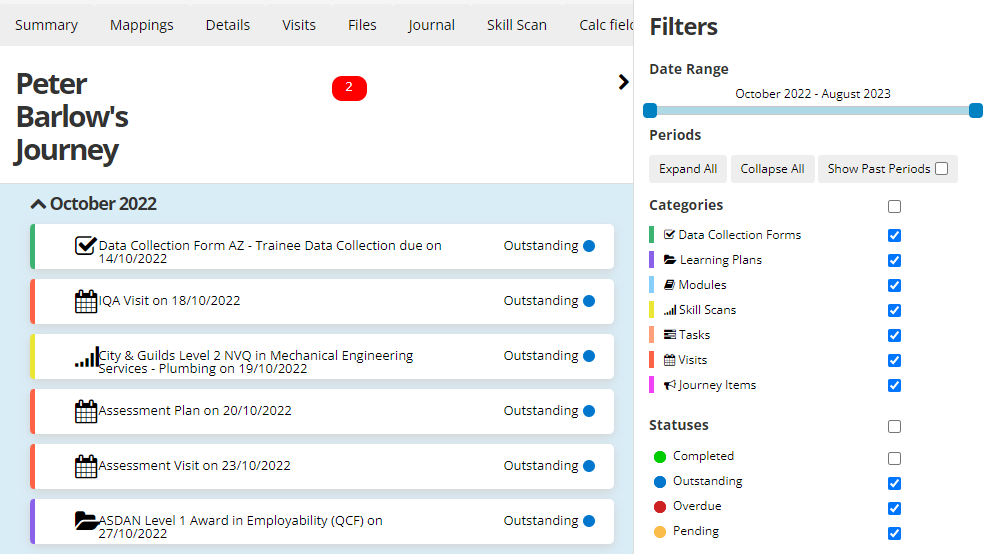
-
Date Range - The buttons on either side of the slider can be used to limit the months shown.

- Periods - These options allow you to expand all periods, collapse all periods or show past periods.
- Categories - These let you choose which categories to include. The box at the top (across from the Categories header) lets you select or de-select all options.
- Statuses - These let you choose which item statuses to include. The box at the top (across from the Statuses header) lets you select or de-select all options.
Add Item Button
An Add Item button can be enabled on the Learner Journey screen which allows you to quickly add any of the items which can appear on the Learner Journey.
To enable the button:
- Go to Web User Editor on the sidebar.
- Search for and select the user that requires permission.
- Click Permissions to expand that section.
- In the Assessor section, tick the Allow Add Journey Items permission.
- Click Save.
The button will now be available at the top-right of the Learner Journey screen. Clicking it will open a panel on the right where you can choose which type of item to add, which will then take you to the relevant wizard for adding the item.

The Journey Items option at the bottom of the list lets you add a simple custom item which only appears in the Learner Journey.
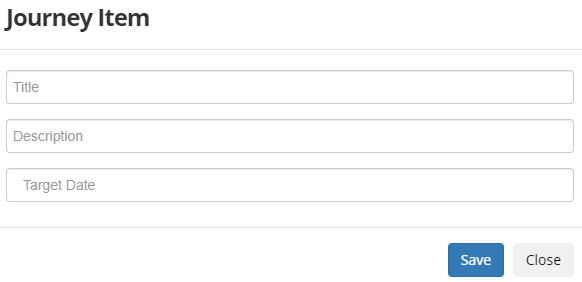
This will then appear in the month set by the Target Date.
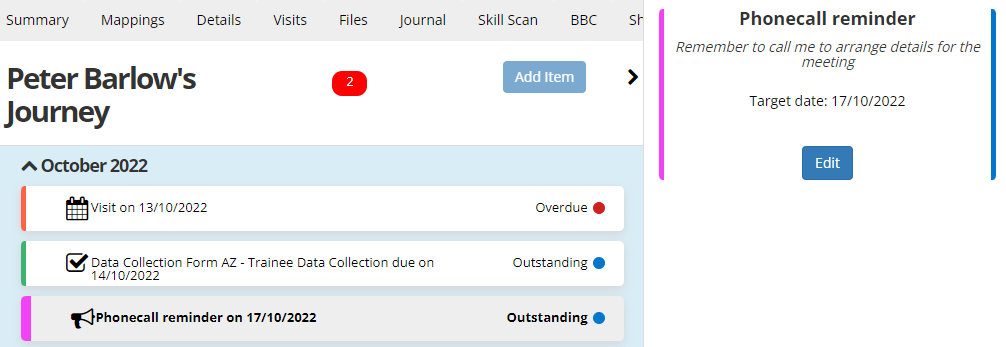
When the learner selects this in their Learner Journey, they will have a button to complete and comment on the note.
Learner Journey as Learner Homepage
The Learner Journey screen can be set as the homepage for learner logins:
- Go to Web User Editor on the sidebar.
- Search for and select the learner.
-
In the Account Details section, select Learner Journey from the Start Page dropdown box.
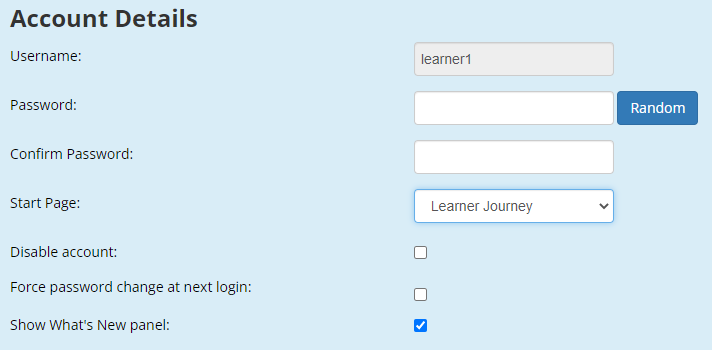
- Click Save.
Configurable OTJ Column on Caseload
The Browse Learners / Caseload screen can be configured to show an OTJ Summary column, which displays a progress bar of a learner's recorded off-the-job training activity compared to their calculated required OTJ hours (as shown on the learner's Off The Job Training tab).

The calculation used to produce the progress bar percentage is:
( (Off the job calculator - OTJ hours remaining) / Off the job calculator) x 100
e.g. if the OTJ calculator showed 80 required hours and there were 40 OTJ hours remaining, the progress bar would be at 50%.
You can also hover over the progress bar to view the remaining and total hours.

To add the OTJ Summary column to the caseload screen:
- Go to Settings on the sidebar.
- Click the System configuration button.
- Go to Assessor Login on the left (under the Maytas Hub Online header).
- In the General section, tick the box for the List of extra columns to show on the caseload screen setting and then tick the OTJ Summary option in the list of extra columns.
- Click Save.
Data Collection Forms - Email Confirmation
A confirmation email can now be sent to a learner once they complete a data collection form, which is enabled by setting a flag against the form in the Maytas Screen Designer:
- In Maytas 5, go to Tools on the toolbar and select New / Load on the Screens panel of the ribbon.
- Open the required form.
- On the Overview tab (on the left of the Screen Designer), tick the Email Learner checkbox.
- Click Apply.
- Go to Home on the toolbar and click the Sync button.
A configuration option is available to specify the content of the email:
- In Maytas Hub, go to Settings on the sidebar.
- Click the System configuration button.
- Go to Learner Login on the left (under the Maytas Hub Online header).
- In the Data Collection section, tick the checkbox for the Trainee Data Collection Completion Email config.
- In the textbox for the config, enter the email body you wish to be sent to learners upon completion of a form. This can include the parameters {FNAME} and {LNAME}, which will display the learner's first and last names in the email.
- Click Save.
County Dropdown Box
When adding or editing a learner, assessor or employer, the County field is now a dropdown box using lookups, rather than a text box, which is consistent with how the County field works in Maytas 5.
Terminated Learners in Search Results
The Find Learners tool now lets you easily see which learners in the results are live and which are terminated, as well as being able to filter by only showing live learners.
To access the Find Learners tool, go to Browse Learners on the sidebar and click the Find Learners tab.
By default, when you search for a learner you will see both live and terminated learners in the search results. The details for terminated learners are faded.
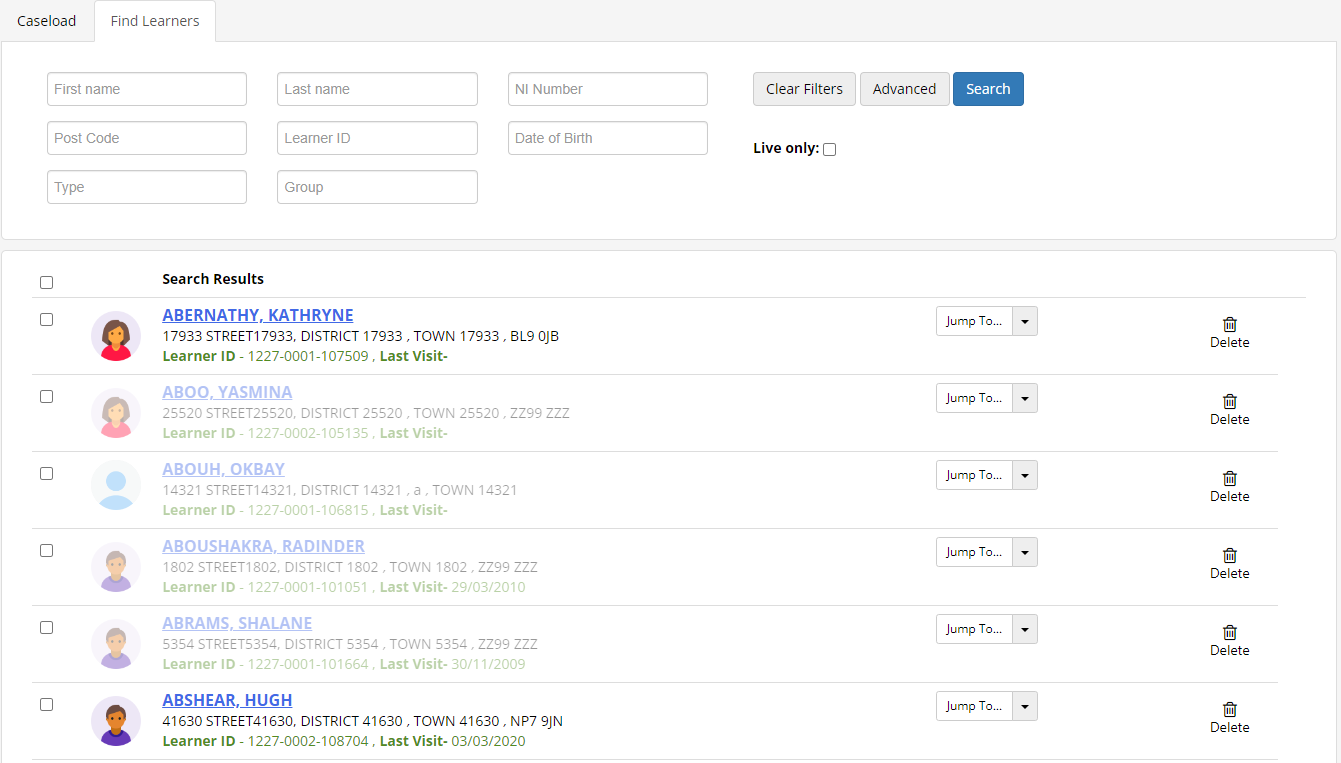
If you only wish to see live learners in the results, tick the Live only box at the top, then click the Search button again.
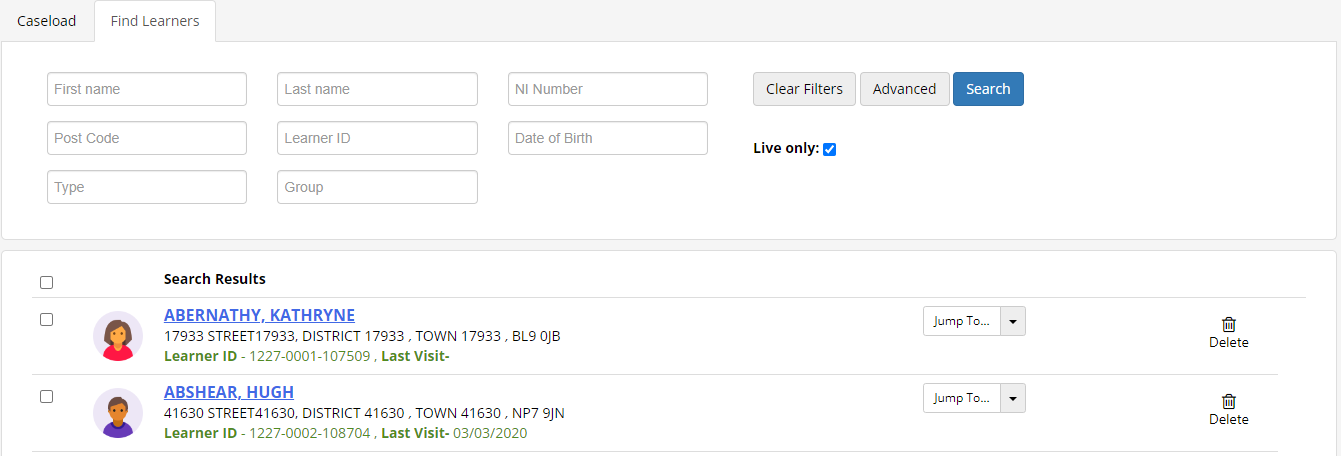
User Panel Overhaul
The power button at the top-right of Maytas Hub has been replaced with a user icon, which leads to a user panel with a variety of options.
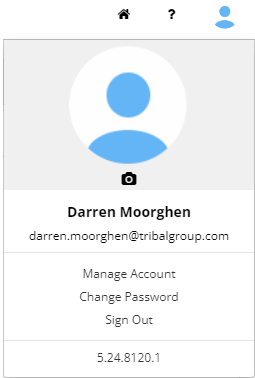
A profile image can be uploaded by clicking the default user icon at the top of the panel. The image must be a .jpg or a .png file, which is then stored on the file store once uploaded (note that if a new image is uploaded to replace an existing one, the old image is deleted).
If a user has access to the web user editor, the Manage Account option will be available. This opens the user's own account in the web user editor.
For learner and employer users, the Accessibility Mode toggle button and Accessibility Statement now appear in the user panel.

Auto-Unlock After Form Completion - Return to Homepage
When a user account has been locked until all pending data collection forms have been completed (see details here), the account will now automatically unlock and go to the homepage upon completion.
This can optionally be disabled so that the account will be unlocked upon completion, but the user will be logged out instead of going straight to the homepage:
- Go to Settings on the sidebar.
- Click the System configuration button.
- There are separate configs for assessor, employer and learner users.
- For assessor users, go to Assessor Login on the left (under the Maytas Hub Online header)
- For employer users, go to Employer Login on the left (under the Maytas Hub Online header).
- For learner users, go to Learner Login on the left (under the Maytas Hub Online header).
- In the Data Collection section, untick the box for the Unlock accounts upon successful data collection setting on the right and ensure the toggle button is set to OFF.
- Click Save.
Data Collection Forms Save Validation Config
A new configuration option is available which lets you choose how saving is handled when completing a data collection form:
- Go to Settings on the sidebar.
- Click the System configuration button.
- Go to Admin on the left (under the Maytas Hub Online header).
-
In the Data Collection section, ensure the box is ticked for the Enable Save button on Data Collection Forms and choose one of the following options from the dropdown box:
-
On with validation - This is the default option, which applies validation to the form when the Save button is clicked.
-
On without validation - This will allow form saving, but won't apply validation to the form when saving (this is how saving worked on forms in previous versions of Maytas Hub).
-
Off - The Save button is disabled, so that only the Submit button can be clicked.
-
- Click Save.
Evidence Criteria Applied via Tasks Across Multiple Modules
When a task associated with multiple modules (each with evidence criteria) is completed for a learner, the criteria from each of the modules will now be applied to the learner. Previously this method only supported criteria being applied from a single module at a time.
To set up a task that can apply criteria across multiple modules, module templates must first be created (if you do not already have them for the relevant modules):
- Go to Browse Modules on the sidebar.
- Search for the required module and click it in the search results.
- Go to the Templates tab.
- Click the Add New Template button.
- Enter a name and description for the template and tick the Active box.
-
Tick the objectives and criteria you wish to include in the template.
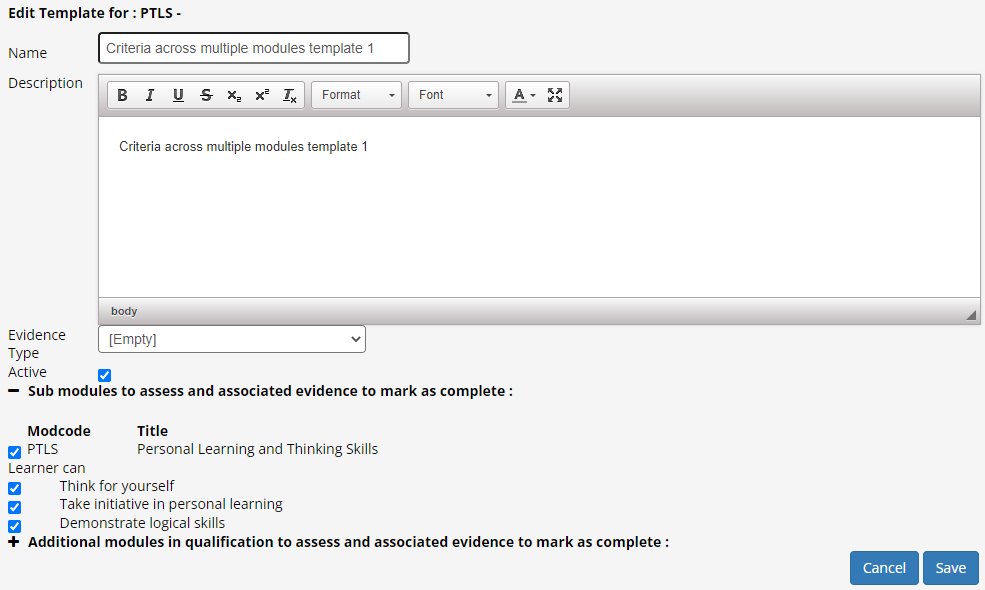
- Click Save.
- Repeat the above steps for additional modules that you wish to add templates for.
Once you have templates set up, a task must be created which will use the templates:
- Go to Tasks on the sidebar.
- Click the New Task button.
-
Enter a title and description and set the Active toggle button to a tick.
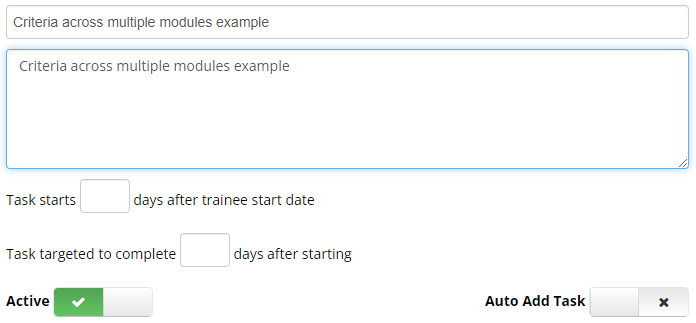
- Set any other options as required and click Save.
- Go to the Associated Templates tab.
- Click the Templates button.
-
For each template created above that you wish to include, search for the template and tick the box to the left of it to select it, then click the Add Selection button.

- Once all required templates have been added, click the Save Task button.
Finally, the task can be applied to a learner:
- Open the learner record and click the Manage Tasks button on the Summary screen.
-
Go to the Manage Tasks tab. The newly-created task should be visible if the learner has corresponding modules associated with them.

-
Click the toggle button next to the task to enable it and set the start and target dates as required.

- Click Save.
- To complete the task and complete the criteria on it for the learner's objectives, create a visit for the learner and go to the Tasks tab in the visit planner.
-
Select the task (the circle should change to a tick), select the evidence files and click the Complete button.
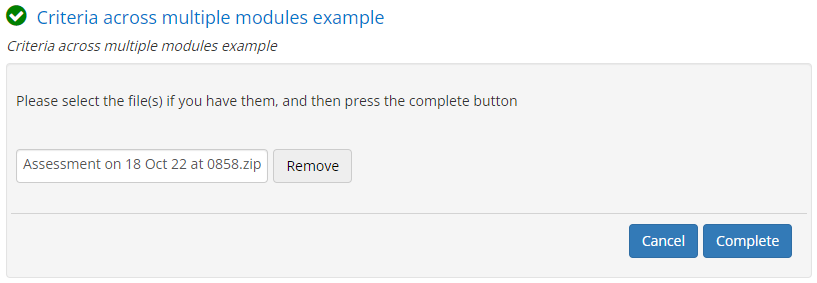
-
The evidence will now be completed on all applicable modules.
